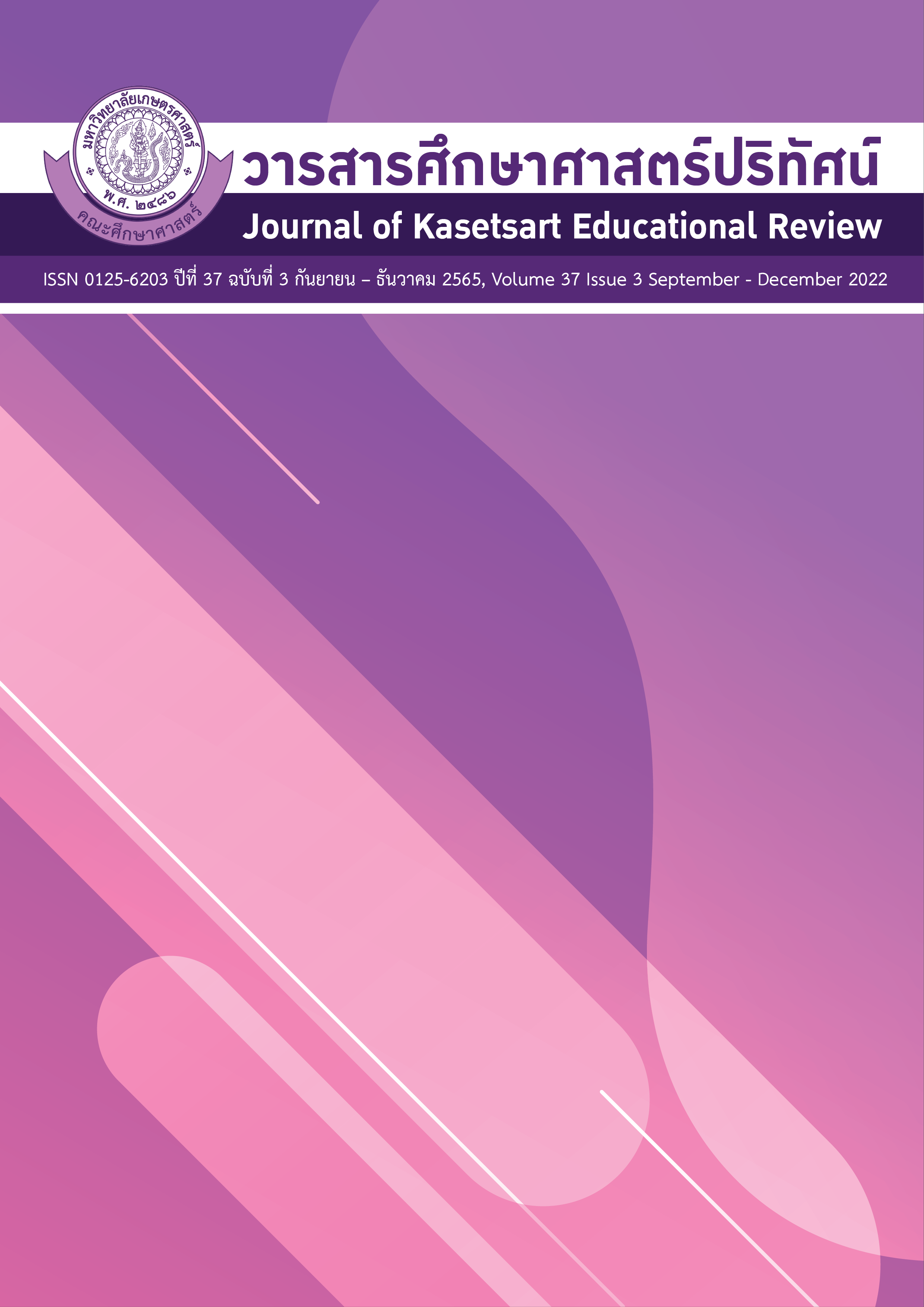การพัฒนาเจตจำนงเด็กปฐมวัยผ่านการเล่นลูสพารตส์
คำสำคัญ:
เจตจำนง, เด็กปฐมวัย, การเล่นลูสพารตส์บทคัดย่อ
ปฐมวัยเป็นช่วงเวลาสำคัญในการบ่มเพาะและเสริมสร้างคุณลักษณะที่จำเป็นให้แก่เด็ก โดยเฉพาะความเพียรซึ่งเป็นความมุ่งมั่นทำในสิ่งที่ตั้งใจจนสำเร็จโดยไม่ล้มเลิกไปโดยง่าย เจตจำนง คือ ความตั้งใจ
ความพยายามบากบั่นจนเกิดเป็นความรักในสิ่งที่ทำอันเป็นบ่อเกิดของความเพียร ทุกการกระทำของเด็กไม่ว่าจะเป็นการกระทำที่รู้ตัวหรือไม่รู้ตัว ล้วนเกิดขึ้นจากเจตจำนง ดังนั้น ผู้ใหญ่รอบข้าง คือ ผู้ที่มีบทบาทสำคัญในการพัฒนาเจตจำนงของเด็กให้ไปสู่ทิศทางที่ถูกต้อง เหมาะสม และดีงาม เนื่องจากเด็กเรียนรู้จากประสบการณ์และสิ่งแวดล้อมรอบตัว การจัดสภาพแวดล้อมที่พรั่งพร้อมด้วยลูสพารตส์ ซึ่งเป็นสื่อปลายเปิดที่หาได้ง่ายในชีวิตประจำวัน ได้แก่ วัสดุธรรมชาติ วัสดุที่ทำจากไม้ พลาสติก โลหะ เซรามิก/ แก้ว ผ้า/ ริบบิ้น และบรรจุภัณฑ์ การเปิดพื้นที่และให้เวลาแก่เด็กได้เล่นอิสระภายใต้การดูแลและการสังเกตของผู้ใหญ่ การเป็นเพื่อนร่วมเล่นกับเด็ก โดยให้เด็กเป็นผู้นำในการเล่น การใช้คำถามปลายเปิดกระตุ้นความคิด จินตนาการ และภาษา รวมถึงการจัดเตรียมลูสพารตส์กลางแจ้งที่มีขนาดใหญ่ ซึ่งช่วยส่งเสริมพฤติกรรมกล้าเสี่ยงแก่เด็ก นำไปสู่ความมั่นใจในตนเอง การกำกับตนเอง ความสามารถในการแก้ปัญหา การตัดสินใจ รวมทั้งการมีเจตจำนงที่แข็งแกร่งซึ่งเป็นคุณลักษณะสำคัญต่อ
การเติบโตและเรียนรู้ในศตวรรษที่ 21
เอกสารอ้างอิง
Attfield, K. (2021). The young child’s journey of “the will”: A synthesis of child-centered and inclusive principles in international Waldorf early childhood education. Journal of Early Childhood Research, 20(2), 159-171. https://doi.org/10.1177/1476718X211051184
Biel, L., Peske, N., & Grandin, T. (2009). Raising a sensory smart child: The definitive handbook for helping your child with sensory processing issues, revised and updated edition. London: Penguin Books.
Blythe, S. G. (2005). The well balance child. Hawthorn.
Casey, T., & Robertson, J. (2019). Loose parts play: A toolkit. Inspiring Scotland.
Daly, L., & Beloglovsky, M. (2015). Introducing loose parts to preschooler. Teaching Young Children, 9(1), 18-20.
Early Childhood Education, Faculty of Education, Chulalongkorn University. (2021). Manual book of Loose parts play to promote creative thinking in young children. Goodhead Printing & Packaging Group. [in Thai]
Flannigan, C., & Dietze, B. (2017). Children, outdoor play, and loose parts. Journal of Children Studies, 42(4), 53-60. https://doi.org/10.18357/jcs.v42i4.18103
Gottfried, A. E. (1983). Intrinsic motivation in young children. Young Children, 39(1), 64-73. https://www.jstor.org/stable/ pdf/42658350.pdf
Joshi, A., & Hinkley, T. (2021, August 4). Too much time on screens? Screen time effects and guidelines for children and young people. https://aifs.gov.au/ cfca/2021/08/05/too-much-time-screens-screen-time-effects-and-guidelines-children-and-young-people
Khan, S. [Khan Academy]. (2020, May 7). Angela Duckworth talks about helping children develop grit and resilience (Video). YouTube. https://www.youtube.com/ watch?v=Uz_oMfsPWsU
Khayankij, S. & Chinsangthip, S. (2022). Factors affecting children’s resilience and happiness during COVID-19 pandemic in Thailand. https://www.childresearch. net/projects/pdf/crna_2022_02.pdf
Ludick, P. (2013). The work of the hand. North American Montessori Teachers’ Association, 38(2), 89. https://files.eric.ed. gov/fulltext/ EJ1077210.pdf
Nakchuen, P., & Khayankij, S. (2021). Parents’ roles in promoting play for preschoolers in Bangkok. An Online Journal of Education, 16(2), Article OJED 1602006. https://so01.tci-thaijo.org/index.php/OJED/article/download/248250/168514 [in Thai]
Office of the National economic and Social Development Council. (2019). Master plan under national strategy Issue 11: Human Capability for all age of life. Office of the Prime Minister. [in Thai]
Panosot, P. (2002). Learning of Thai early childhood children in Waldorf Education. http://www.bks.ac.th/lms/ ebook/pdf/4306005/pdf.pdf [in Thai]
Spitalny, S. (2012). Connecting with young children: Educating the Will. Chamakanda.
Sutton, M. J. (2011). In the hand and mind: The intersection of loose parts and imagination in evocative settings for young children. Children, Youth and Environments, 21(2), 408-424. https://www.jstor.org/stable/10.7721/chilyoutenvi.21.2.0408#metadata_info_tab_contents
Topothai, T., Suphanchaimat, R., Topothai, C., Tangcharoensathien, V., Cetthakridul, N., & Waleewong, O. (2022). Self-reported parental interactions through play with young children in Thailand: An analysis of the 2019 Multiple Indicator Cluster Survey (MICS). International Journal of Environment Research and Public Health, 19(6), 3418. https://doi.org/10.3390/ ijerph19063418.
ดาวน์โหลด
เผยแพร่แล้ว
ฉบับ
ประเภทบทความ
สัญญาอนุญาต
ลิขสิทธิ์ (c) 2022 วารสารศึกษาศาสตร์ปริทัศน์

อนุญาตภายใต้เงื่อนไข Creative Commons Attribution-NonCommercial-NoDerivatives 4.0 International License.
บทความทุกบทความเป็นลิขสิทธิ์ของวารสารคณะศึกษาศาสตร์ มหาวิทยาลัยเกษตรศาสตร์ วิทยาเขตบางเขน
วารสารศึกษาศาสตร์ปริทัศน์ (Kasetsart Educational Review)






